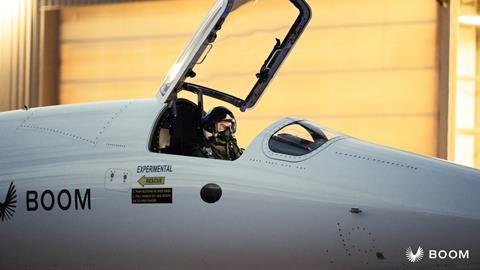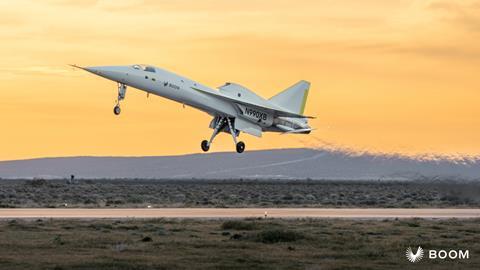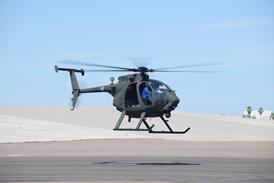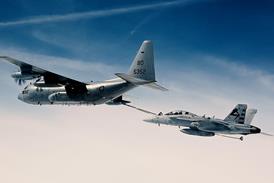Boom Supersonic’s XB-1 demonstrator took off for the first time on 22 March and completed a 12min maiden sortie during which it climbed to 7,120ft and hit 238kt (441km/h).
Flying from Boom’s flight-test base at Mojave Air & Space Port in California, the jet got airborne at 07:28 local time and landed at 07:40, with Boom chief test pilot Bill Shoemaker at the controls, says the company.
The flight comes several years after Boom had initially predicted and marks a significant milestone for the start-up, which aims for XB-1 to inform its development of a passenger supersonic aircraft. Boom released a video of the milestone.
“Two decades after Concorde’s retirement, the first flight of XB-1 marks the return of a civil supersonic aircraft to the skies and paves the way for the revival of mainstream supersonic travel onboard Overture,” Boom says. “While XB-1 was in the air, the team performed an initial assessment of the aircraft’s handling qualities, including airspeed checks with the T-38 chase aircraft, and assessing the aircraft’s stability in the landing attitude.”
Overture is Boom’s ultimate goal. That jet is to carry 64-80 passengers, fly at Mach 1.7 and have 4,250nm (7,871km) of range. Boom has said it intends to deliver the first Overture in 2029.
Now, the company plans to complete more test flights during which it will “systematically expand the flight envelope to confirm [XB-1’s] performance and handling qualities through higher speeds”.
“This includes in-flight checks of all systems, as well as multiple test points demonstrating safe margin to flutter (vibration) boundaries,” Boom says. “We anticipate a total of 10-20 flights before we reach supersonic flight.”

Boom has applied to the Federal Aviation Administration for a special flight authorisation to fly XB-1 at supersonic speeds over the Mojave desert. Civilian overland supersonic flight is otherwise banned.
XB-1 will help Boom validate technologies including supersonic aerodynamics, the use of carbon-fibre materials (XB-1 is made mostly from carbon fibre) and an augmented-reality vision system composed of nose-mounted cameras that provide pilots with better runway visibility, Boom says.
The demonstrator is powered by three GE Aerospace J85-15 engines. It is 19.7m (62.6ft) long and has a 6.4m wingspan.

Boom revealed the demonstrator in October 2020, at the time saying it would fly in 2021. Delays persisted, and in early 2023 Boom said it moved XB-1 from a hangar near Denver to Mojave Air & Space Port. In August last year; the company said it had received an airworthiness certification for XB-1 from the FAA.
Developing a clean-sheet supersonic passenger jet is a tall order for any company.
Boom faces many challenges, including timing. The company is attempting to make supersonic travel mainstream as the aerospace industry is pushing hard to reduce carbon output – not a favourable trend because supersonic aircraft burn more fuel, not less, per passenger.
Amid such pressure, major engine manufacturers in recent years expressed disinterest in developing an engine for Overture. Rolls-Royce, which had performed early studies for Boom, backed out in 2022.
In response, Boom in late 2022 said it was developing its own engine, called Symphony, with support from three partners: GE Additive, maintenance firm StandardAero and missile-engine-maker FTT, a business unit of Kratos Defense & Security Solutions.
The company is also building an Overture production facility in Greensboro, North Carolina.



























